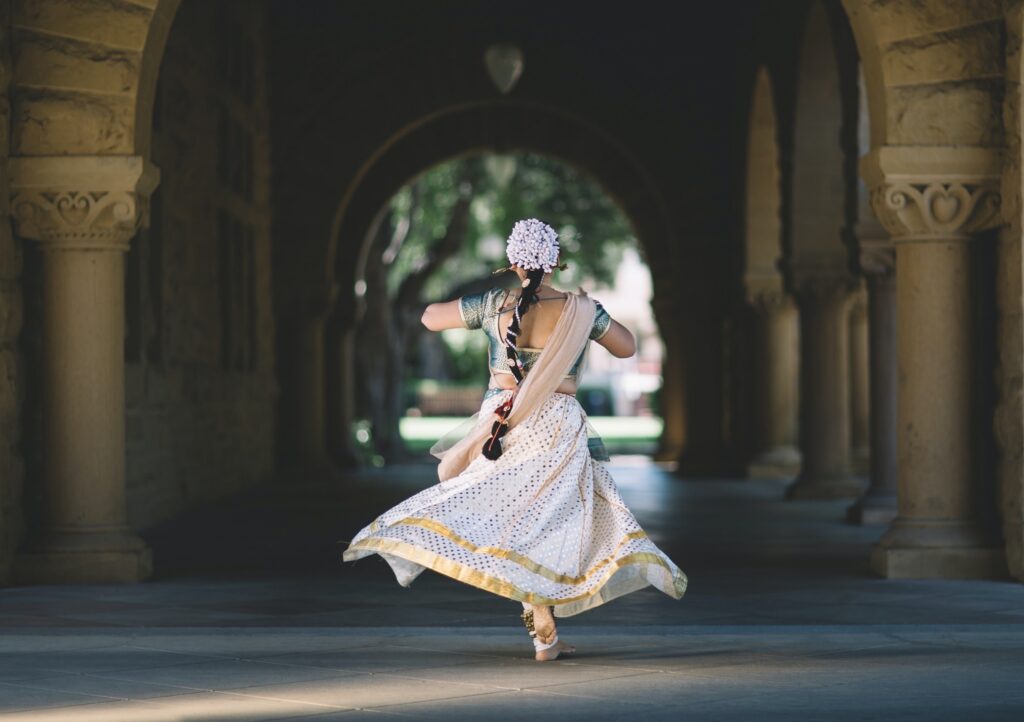India is a colorful country and some of its beautiful colors are painted by the state of Rajasthan. The desert might lead to scarcity of water but there is an abundance of cheer and colors here. Kathak Jaipur Gharana is one of its vibrant colors.

Rajasthan was the seat of the Rajput Kingdom and Amber which is known as Jaipur today was an important kingdom. Even when the Mughals invaded India, Rajput stood strong against them and protected their rich cultural heritage. Kathak was and is an integral part of Rajasthan’s ravishing culture. It kept developing under the patronage of Rajput rulers.
Kathak Gharanas
Kathak is an Indian classical dance that is derived from the Sanskrit word Katha which means story. The dance was slowly given shape by the wanderers who performed stories from mythological legends to worship God and entertain people. Since Jaipur was less influenced by Mughal culture as compared to Lucknow, the Jaipur Gharana is more inclined towards traditional techniques.
Gharanas can be understood as the different branches or schools of Kathak. While the beauty of Kathak remains the same in all the Gharanas, each one of them specializes in certain techniques and aspects of this famous classical dance of Northern India.
Jaipur Gharana and Shiv Tandav
Kathak Jaipur Gharana is a branch of Kathak which is best known for its marvelous representation of Veer Ras. Veer Ras translates to “Bravery Genre” and includes strong and swift movements.
Jaipur Gharana of Kathak was conceived by Bhanu Ji Maharaj. He learned Shiv Tandav from a saint and continued to pass this culture to the coming generations. Shiv Tandav is an aggressive dance form of Kathak. It is believed by Hindus that Lord Shiva performed Tandav to channel his anger. In Tandav, the dancer performs bold moves on fast beats with high energy. The art is in controlling the energy instead of being lost in the flow.
The Grandson of Bhanu Ji Maharaj, Kanhu Ji was finding the way to balance the intensive energy of Kathak. His Journey ended at Vrindavan where he learned Lasya. Lasya is another form of Kathak in which soft movements are used to express feelings and match the beats.
While Tandav is inclined towards Veer Ras, Lasya is more focused on Shringaar Ras (Feminine Genre). Since Tandav requires Sturdy body postures, Strong body movements, and Aggressive expressions it was considered more suitable for men. And since only men were allowed to perform Kathak during those times, Tandav was more popular in Jaipur Gharana.
Rajput Rulers and Jaipur Gharana
You must have heard about Akbar’s Navratanas, but did you know about the “Gunijan Khana” in Rajput Kingdoms? Alike the Navratanas, Gunijan Khana included brilliant artists who use to entertain the King. Rajputs took pride in their culture and did the best to promote it.
Rajput Kings appreciated Kathak as well. While the Mughal invasion was bringing women to perform Kathak in courts, Rajput still frowned upon this idea. Another reason why Jaipur Gharana is associated with Veer Ras is that for a long-time only men performed Kathak, consequently, strength became an essential ingredient of Jaipur Gharana.
How is Jaipur Gharana different from Banaras and Lucknow Gharana?
Jaipur Gharana of Kathak was founded by Bhanu Ji Maharaj who was a Maestro in Shiv Tandav. Thus, the influence of Veer Ras is evident in Jaipur Gharana. Jaipur Gharana specializes in fast dance moves delivered with perfection. As a gift from its strong history, Jaipur Gharana can effortlessly perform on difficult and fast beats.
Unlike, Lucknow Gharana which focuses on expressions, Jaipur Gharana emphasizes powerful footwork. Unlike Banaras Gharana, Jaipur Gharana uses numerous swift Chakkars (pirouettes) throughout the performance.
Kathak Jaipur Gharana Essence
The essence of Kathak Jaipur Gharana is strength and precision. It was born from the seed of Shiv Tandav and soon the successors learned Lasya and nurtured it with soft moves. Today you can find a Jaipur Gharana dancer wearing a wide cut dazzling Lehenga accompanied with a gorgeous blouse on the top.
The dancer will accessories her look with a dupatta falling from her shoulder and held by a waist belt. Her neck will be covered with a long and a short necklace and her forehead will be adorned with a matching Maang Teeka. With bangles on her wrists and Ghunghroors (ankle bells) on the ankles, she will start dancing in Vilambhit Laya(slow beats) and eventually startle you with the powerful yet smooth moves on the fast beats.

Pingback: Eight Classical Dances of India As Per Sangeet Natak Akademy - Auchitya
Pingback: Kathak Lucknow Gharana - House of Pandit Birju Maharaj - Auchitya
Pingback: Kathak Lucknow Gharana - House of Pandit Birju Maharaj - Auchitya
Pingback: Kathak - Classical Dance of Uttar Pradesh - Auchitya
Pingback: 8 Classical Dances of India As Per Sangeet Natak Akademy - Auchitya